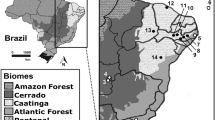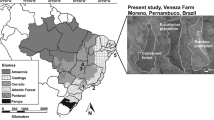Abstract
Modern environmental destruction through human action has had a big impact on biological diversity. In the Brazilian Cerrado, the second largest South American biome, more than 60% of the native vegetation has been devastated mainly due to anthropic activities. One of the consequences of these activities is the distinct dispersion patterns of endemic and colonizer species in urban environments. In this report we assess the colonizing potential of drosophilids in environments with different grades of urbanization, defined according to the vegetation cover, edifications and demographic density. We performed 12 monthly collections in the city of Brasília, the capital of Brazil, which is located in the core region of the Cerrado. Although we identified 16 species, 90% of the 22,509 captured specimens were Zaprionus indianus, a species recently introduced in Brazil, and the cosmopolitan D. simulans. We captured all the exotic species that occur in the Biome, with the exception of D. kikkawai, but only 8 from the 25 endemic species that occur in natural sites around Brasília. The abundance of four endemic species (D. nebulosa, D. sturtevanti, D. cardini and D. prosaltans) decreased as the grade of urbanization increased. D. immigrans, an exotic species, showed the opposite pattern. We concluded that most endemic species of Drosophilidae are not able to colonize the new environment represented by the city, and that some species of this family may detect not only environmental alteration, by their presence or absence, but also the grade of environmental disturbance, by their relative abundance.
Similar content being viewed by others
Abbreviations
- RECOR/IBGE:
-
Roncador Ecological Reserve
- NPB:
-
National Park of Brasília.
References
J.L. Avondet R.B. Blair D.J. Berg M.A. Ebbert (2003) ArticleTitleDrosophila (Diptera: Drosophilidae) response to changes in ecological parameters across an urban gradient Environmental Entomology 32 347–358
Bächli G. 2003. TaxoDros: The database on Taxonomy of Drosophilidae. Consulted on-line on April 2003. URL: http://taxodros.unizh.ch/.
M. Belo (1979) ArticleTitleEspécies domésticas de Drosophila – diversidade de espécies atraídas para isca de banana fermentada naturalmente Científica 7 145–153
M. Belo J.J. Oliveira-Filho (1976) ArticleTitleEspécies domésticas de Drosophila. V: Influências de fatores ambientais no número de indivíduos capturados Revista Brasileira de Biologia 36 903–909
M. Belo A.J. Gallo (1977) ArticleTitleDomestic Drosophila species Drosophila Inform. Service 52 138
C.B.C. Bonorino V.L.S. Valente (1989) ArticleTitleStudies on wild and urban populations and breeding sites of Drosophila nebulosa Revista Brasileira de Biologia 49 771–776
C.B.C. Bonorino V.L.S. Valente S.M. Calegari-Jacques (1993) ArticleTitleUrbanization and chromosomal polymorphism of Drosophila nebulosa Revista Brasileira de Genética 16 59–70
Brasil (1998) Ministério do Meio Ambientedos Recursos Hídrico e da Amazônia Legal Primeiro Relatório Nacional para a Convenção sobre a Diversidade Biológica BrasíliaBrazil 283
H. Burla C. Pavan (1953) ArticleTitleThe ȁ8callopteraȁ9 group of species (DrosophilaDiptera) Revista Brasileira de Biologia 13 291–314
M.T. Chassagnard L. Tsacas (1993) ArticleTitleLe sous-genre Zaprionus S. Str. Définition de groupes dȁ9éspécies et révision du sous-groupe vittiger (DipteraDrosophilidae) Annales de la Société Entomologique de France 29 173–194
T. Dobzhansky (1965) ‘Wild’ and ‘domestic’ species of Drosophila H.G. Baker G.L. Stebbins (Eds) The Genetics of Colonizing Species Academic Press New York 533–551
Th. Dobzhansky C. Pavan (1950) ArticleTitleLocal and seasonal variations in relative frequencies of species of Drosophila in Brazil Journal of Animal Ecology 19 1–14
L. Ehrman J.R. Powell (1982) The Drosophila willistoni species group M. Ashburner H.L. Carson J.N. Thompson (Eds) The Genetics and Biology of DrosophilaVol. 3b Academic Press London 193–226
G. Eiten (1972) ArticleTitleCerrado Vegetation of Brazil Botanical Review 38 201–341
N. Freire-Maia C. Pavan (1949) ArticleTitleIntrodução ao estudo da drosófila Cultus 1 1–171
B. Goñi M.E. Martinez P. Daguer (1997) ArticleTitleStudies of two Drosophila (DipteraDrosophilidae) communities from urban MontevideoUruguay Revista Brasileira de Entomologia 41 89–93
A.J. Gray M.J. Crawley P.J. Edwards (Eds) (1987) Colonization, Sucession and Stability Blackwell Publishers OxfordUK
J. Hilty A. Merenlender (2000) ArticleTitleFaunal indicator taxa selection for monitoring ecosystem health Biological Conservation 92 185–197 Occurrence Handle10.1016/S0006-3207(99)00052-X
INMET 2004. Instituto Nacional de Meteorologia. Ministério da AgriculturaPecuária e DesenvolvimentoBrasil, URL: http:// www.inmet.gov.br/ climatologia/ combo climatologia_I.html.
C. Kremen R.K. Colwell T.L. Erwin D.D. Murphy R.F. Noss M.A. Sanjayan (1993) ArticleTitleTerrestrial arthropod assemblages – their use in conservation planning Conserv. Biol. 7 796–808 Occurrence Handle10.1046/j.1523-1739.1993.740796.x
R.C. Lewontin (1965) Selection for colonizing ability H.G. Baker G.L. Stebbins (Eds) The Genetics of Colonizing Species Academic Press New York 77–91
L.E. Magalhães (1962) ArticleTitleNotes on the taxonomy, morphology, and distribution of the saltans group of Drosophilawith descriptions of four new species Univ. Texas Publ. 6205 134–154
E. Mayr (1965) Summary H.G. Baker G.L. Stebbins (Eds) The Genetics of Colonizing Species Academic Press New York 553–562
C.E. McCoy (1962) ArticleTitlePopulation ecology of common species of Drosophila in Indiana Journal of Economic Entomology 55 978–985
N.E. McIntyre (2000) ArticleTitleEcology of urban arthropods: a review and a call to action Annals of Entomological Society of America 93 825–835
N.E. McIntyre J. Rango W.F. Fagan S.H. Faeth (2001) ArticleTitleGround arthropod community structure in a heterogeneous urban environment Landscape and Urban Planning 52 257–274 Occurrence Handle10.1016/S0169-2046(00)00122-5
G.K. Meffe C.R. Carroll (1997) Principles of Conservation Biology Sinauer Associates Inc SunderlandMA
R.A. Mittermeier N. Myers P.R. Gil C.G. Mittermeier (1999) Hotspots: Earth’s Biologically Richest and Most Endangered Terrestrial Ecoregions CEMEX/Conservation International Mexico City, Mexico
P.S. Oliveira R.J. Marquis (Eds) (2002) The Cerrados of Brazil Columbia University Press New York
S.R. Palumbi (2001) ArticleTitleHumans as the World’s greatest evolutionary force Science 293 1786–1790 Occurrence Handle1:CAS:528:DC%2BD3MXmvVSltro%3D Occurrence Handle11546863
R. Parkash J.P. Yadav (1993) ArticleTitleGeographical clinal variation at 7 esterase-coding loci in Indian populations of Zaprionus indianus Hereditas 119 161–170 Occurrence Handle1:STN:280:ByuC2cfmvFI%3D Occurrence Handle8106261
P.A. Parsons (1982) ArticleTitleEvolutionary ecology of Australian Drosophila: a species analysis Evolutionary Biology 14 297–350
P.A. Parsons (1983) The Evolutionary Biology of Colonizing Species Cambridge University Press CambridgeUK
P.A. Parsons (1987) Features of colonizing animals: phenotypes and genotypes A.J. Gray M.J. Crawley P.J. Edwards (Eds) Colonization, Succession and Stability Blackwell OxfordUK 133–154
P.A. Parsons (1991) ArticleTitleBiodiversity conservation under global climatic change: the insect Drosophila as a biological indicator? Global Ecology and Biogeography 1 77–83
P.A. Parsons (1995) ArticleTitleEvolutionary response to drought stress – conservation implications Biological Conservation 74 21–27
P.A. Parsons S.M. Stanley (1981) Domesticated and widespread species M. Ashburner R.F. Wright (Eds) Genetics and Biology of Drosophila Vol. 3a Academic Press London 349–393
J.T. Patterson W.S. Stone (1952) Evolution in the genus Drosophila Macmillan New York
C. Pavan (1950) ArticleTitleEspécies brasileiras de Drosophila. II. Boletim da Faculdade de FilosofiaCiencias e Letras, Universidade de São Paulo (111) Biological Conservation 8 1–37
C. Pavan (1959) ArticleTitleRelações entre populações naturais de Drosophila e o meio ambiente Boletim da Faculdade de FilosofiaCiencias e Letras, Universidade de São Paulo 11 1–81
C. Pavan M.E. Breuer (1954) ArticleTitleTwo new species of ȁ8Drosophilaȁ9 of the Dreyfusi group (Diptera) Revista Brasileira de Biologia 14 459–463
J.R. Powell (1997) Progress and Prospects in Evolutionary Biology, The Drosophila Model Oxford University Press OxfordUK
C. Rhode V.L.S. Valente (1996) ArticleTitleEcological characteristics of urban populations of Drosophila polymorpha Dobzhansky & Pavan and Drosophila cardinoides Dobzhansky & Pavan (DipteraDrosophilidae) Revista Brasileira de Biologia 40 75–79
F.M. Sene F.C. Val C.R. Vilela M.A.Q.R. Pereira (1980) ArticleTitlePreliminary data on the geographical distribution of Drosophila species within morphoclimatic domains of Brazil Papéis Avulsos de Zoologia 33 315–326
F.M. Sene M.A.Q.R. Pereira C.R. Vilela N.M.V. Bizzo (1981) ArticleTitleInfluence of different ways to set baits for collection of Drosophila flies in three natural environments Drosophila Information Service 56 118–121
B. Shorrocks (1977) ArticleTitleEcological classification of European Drosophila species Oecologia 26 335–345
R. Tidon F.M. Sene (1992) ArticleTitleVertical and temporal distribution of Drosophila (DipteraDrosophilidae) species in a wooded area in the state of São Paulo Brazil Revista Brasileira de Biologia 52 311–317
R. Tidon-Sklorz F.M. Sene (1995) ArticleTitleDrosophila seriema: a new member of the Drosophila serido (DipteraDrosophilidae) superspecies taxon Annals of the Entomological Society of America 88 139–142
R. Tidon-Sklorz F.M. Sene (2001) ArticleTitleDrosophila antonietae sp. n. and Drosophila gouveai sp. n.: two new members of the subcluster Drosophila serido (Diptera: Drosophilidae) Iheringia – Série ZoologiaPorto Alegre 90 141–146
R. Tidon D.F. Leite B.F.D. Leão (2003) ArticleTitleImpact of the colonisation of Zaprionus (DipteraDrosophilidae) in different ecosystems of the Neotropical Region: two years after the invasion Biological Conservation 112 299–305
F.C. Val (1982) ArticleTitleThe male genitalia of some Neotropical Drosophila: notes and illustrations Papéis Avulsos de Zoologia 34 309–347
F.C. Val F.M. Sene (1980) ArticleTitleA newly introduced Drosophila species in Brazil Papéis Avulsos de Zoologia 33 293–298
F.C. Val C.R. Vilela M.D. Marques (1981) Drosophilidae of the Neotropical Region M. Ashburner H.L. Carson J.N. Thompson (Eds) The Genetics and Biology of Drosophila Vol. 3a Academic Press London 123–168
V.L.S. Valente A. Ruszezyk R.A. Santos (1993) ArticleTitleChromosomal polymorphism in urban Drosophila willistoni Revista Brasileira de Biologia 16 307–319
V.L.S. Valente A. Ruszczyk R.A. Santos C.B.C. Bonorino B.E.P. Brum L.P. Regner N.B. Morales (1989) ArticleTitleGenetic and ecological studies on urban and marginal populations of Drosophila in the south of Brazil Evolucion Biologica 3 19–35
V.H. Valiati V.L.S. Valente (1996) ArticleTitleObservations on ecological parameters of urban populations of Drosophila paulistorum Dobzhansky & Pavan (DipteraDrosophilidae) Revista Brasileira de Entomologia 40 225–231
V.H. Valiati V.L.S. Valente (1997) ArticleTitleChromosomal polymorphism in urban populations of Drosophila paulistorum Revista Brasileira de Genética 20 567–581
C.R. Vilela (1983) ArticleTitleA revision of the Drosophila repleta species group (DipteraDrosophilidae) Revista Brasileira de Entomologia 27 1–114
C.R. Vilela (1999) ArticleTitleIs Zaprionus indianus Gupta1970 (DipteraDrosophilidae) currently colonizing the Neotropical Region? Drosophila Information Service 82 37–38
C.R. Vilela F.M. Sene (1982) ArticleTitleA new spotted thorax species of the genus Drosophila (DipteraDrosophilidae) Revista Brasileira de Entomologia 26 343–347
C.R. Vilela G. Bächli (1990) ArticleTitleTaxonomic studies on Neotropical species of seven genera of Drosophilidae Bulletin de la Societé Entomologique Suisse 63 1–332
C.R. Vilela M.A.Q.R. Pereira F.M. Sene (1983) ArticleTitlePreliminary data on the geographical distribution of Drosophila species within morphoclimatic domains of Brazil. II. The repleta group Ciência e Cultura 35 66–70
Author information
Authors and Affiliations
Corresponding author
Rights and permissions
About this article
Cite this article
Ferreira, L., Tidon, R. Colonizing potential of Drosophilidae (Insecta, Diptera) in environments with different grades of urbanization. Biodivers Conserv 14, 1809–1821 (2005). https://doi.org/10.1007/s10531-004-0701-4
Received:
Accepted:
Issue Date:
DOI: https://doi.org/10.1007/s10531-004-0701-4




